A New Lease of Life: Pistes with Attitude

Once saddled with a cruel nickname, the French ski resort of Flaine has found fresh admiration for its Brutalist architecture and mid-century sense of style, as Dominic Bliss discovers.
There’s a Picasso living in the French ski resort of Flaine. Standing 12m tall, with a wonky face, misshapen eyes and a triangular nose, she stands near the base station of the cable car. She’s an enlarged version of an original 80cm 1957 sculpture in Paris’s Picasso Museum called ‘La Tête de Femme’. Not far away, keeping her company in the ice-cold air, there are other huge outdoor sculptures.
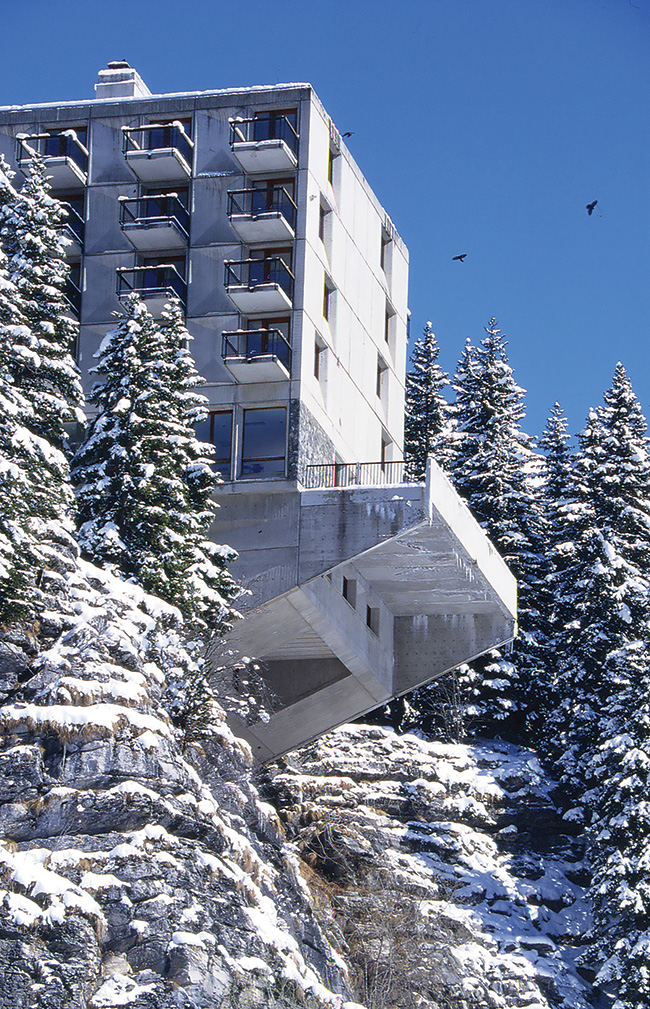
Hôtel Le Flaine by architect Marcel Breuer © Office de Tourisme de Flaine
Sprawling across an embankment is ‘Le Boqueteau des 7 arbres’ (‘The Copse of 7 Trees’) by Jean Dubuffet; on top of the shopping centre is the very colourful ‘Trois Hexagones’ by Victor Vasarely; just next to that is ‘Burnt Trees’ by Philippe Pastor – a copse of real trees burnt by forest fires in Provence; and at the resort entrance is Carl Nesjar’s stainless steel ‘Fontaine de Glace’ (‘Ice Fountain’).
Bold, brash and decidedly mid-century, these works of art certainly aren’t everyone’s cup of tea. But one thing’s for sure: you cannot miss them. Installed between the late 1980s and the 2000s, they stand out starkly against the Brutalist 1960s buildings that surround them. Should you wish to examine them more closely, the town’s art centre offers free guided tours of much of its public art and architecture.
Love it or Hate it
Flaine is one of those Marmite ski resorts: you either love it or you hate it. The buildings are cuboid, grey and concrete, with apartments on the upper levels and shop-lined pedestrian walkways at street level. The streetlights are glass globes, either mounted on vertical metal pillars, or jutting out on horizontal rods. The building name signs are all in a classic mid-century font called Cassandra. The overall effect feels rather functional, much like many of the 1960s council estates you find in towns across Britain.
Years ago, a ski guidebook inflicted Flaine with the rather cruel nickname ‘Phlegm’. Fast forward to the 2020s, however, and architecture fans are reassessing attitudes towards Brutalist or Bauhaus-style concrete blocks. In 2008, France’s Ministry of Culture awarded Flaine the official label of Patrimoine Architectural du XXe siècle (Architectural Heritage of the 20th century).
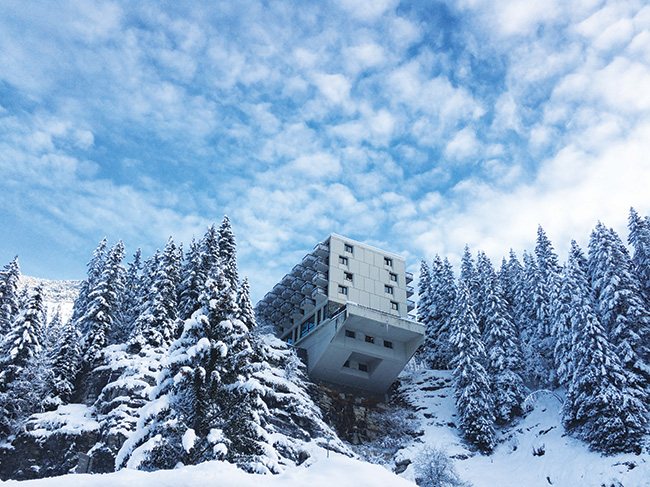
Hôtel Le Flaine is a fantastic example of Brutalist architecture © Office de Tourisme de Flaine
Designed in the 1960s by Hungarian-American architect Marcel Breuer, a student of the Bauhaus school, Flaine, which opened in January 1969, was originally the brainchild of the developers Éric and Sylvie Boissonnas. This is how Breuer, who died in 1981, once promoted his creation: “The architecture of Flaine is an application of the principle of shadow and light. The building façades are cut like diamond points. The sunlight strikes their facets from different angles, their reflections producing contrasts in lighting. The horizontal linear levels of the buildings, a human creation, contrast with the chaotic terrain of the mountain, witness to the awesome power of nature. The entire composition is integrated into the beautiful and wild landscape of Flaine which it embraces and humanises.” The authors of a booklet available at the Flaine arts centre – called Flaine: Architecture of a Ski Resort – are a little less sympathetic. “Flaine is resolutely modern and radical,” they state. “The raw concrete buildings in a high-altitude mountain setting fascinate some and disturb others.
Even now, in the 21st century, the architectural expression of Marcel Breuer is somewhat misunderstood by the public. Flaine does not set out to win approval.” There’s no such criticism when it comes to the skiing, though. Part of Le Grand Massif ski area, Flaine, along with Les Carroz, Morillon, Samoëns and Sixt-Fer-à-Cheval, offers 265km of pistes. Flaine itself boasts some of the best facilities in all of the Haute-Savoie, with 64 pistes and 24 lifts.

There are slopes suitable for little ones too © Office de Tourisme de Flaine
Perfect Conditions for Snow
Locals love to boast that their ski area sits within a vast natural basin, creating meteorological conditions that guarantee great snow for much of the winter. Surrounding the basin is a ring of high mountains, protecting the pistes from the warming effect of the milder westerly and south-westerly winds, and creating a natural amphitheatre. Most of the slopes face north or northwest, thereby avoiding the strongest heat of the sun. In an era of warmer winters, this can only be a bonus. It was this natural basin that gave the resort its name.

Take a break from the skiing with a spot of dog-sledding © Office de Tourisme de Flaine
Legend has it that, aeons ago, a giant was making his way across the mountains and valleys from Lake Geneva south to the Mediterranean. Exhausted by his journey, he stopped for the night in Flaine, resting his enormous head in the mountain bowl. In the Savoyard dialect, the word for pillow is ‘flainoz’, hence Flaine. The pistes on offer here are reassuringly varied in style and difficulty. Beginners can schuss for 14km down the blue run known as the Piste des Cascades, from the top of Les Grandes Platières (at 2,480m) all the way to Sixt, at 760m.
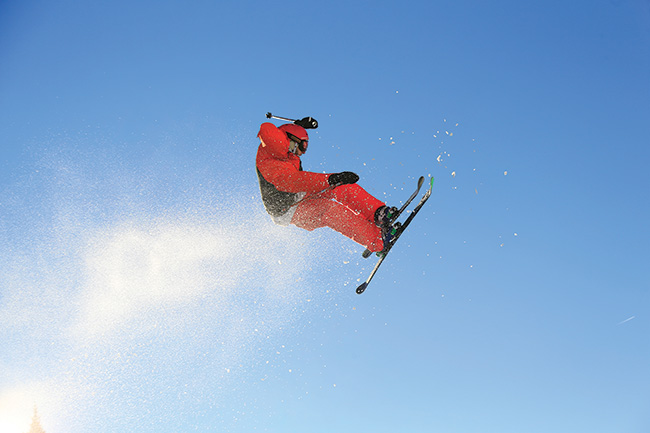
Skiing of all varieties is available here and there are slopes suitable for all skill levels, from beginner to expert © Office de Tourisme de Flaine
Here’s how the resort sells it: “Winding through alpine pasture lands and forests, it boasts at the start a panoramic view of the Mont Blanc peaks. It is not uncommon to spot chamois or ibex from the piste.” Expert skiers will prefer the Gers Bowl. Here they can indulge their love of back-country skiing through an 800m drop through virgin snow. “Marked but not groomed, it is an impressive slope with a favourable orientation,” the resort says. “This does not prevent us from warning even the most experienced among you: there are numerous rocky crags as well as dangerous avalanches.”
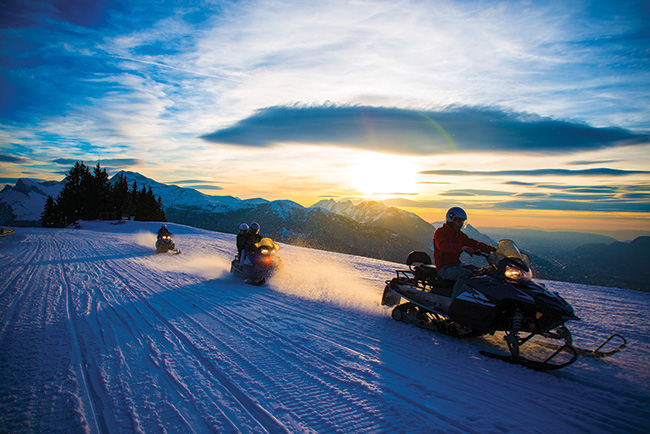
How about a spot of twilight motoneige? © Office de Tourisme de Flaine/ Y. Havis
Fresh Air on the Piste
Fear not, though. Most of the resort’s pistes are either blue or red. And there’s little risk of taking a wrong turn, since all have been given a convenient, themed moniker: the greens are named after alpine trees (pin, érable, épicéa, etc); the blues after gemstones (quartz, saphir, rubis, émeraude, etc); the reds after various diabolical characters (lucifer, faust, belzébuth, démon, etc); and the blacks after minerals (onyx, agate, diamant noir, etc).
When I visited Flaine, back in January 2022, the conditions were absolutely perfect. After the various lockdowns and Covid restrictions, skiers were keener than ever to get out on the slopes again. During lockdown, the French had been restricted to one hour’s exercise a day, within just a kilometre’s radius from their homes. Even up in the mountains of the Haute-Savoie, this rule was enforced with vigour.
So, finally released back onto the slopes after being cooped up for all that time, locals were returning to skiing with glee. Clouds were few and far between, while a warm midwinter sunshine bathed the freshly bashed pistes in a glorious light. At this stage of the winter, there were still very few tourists in town, making for wonderfully rapid lift ascents, and smooth, fast skiing over uncongested runs.

Relax in a whirlpool bath after a hard day on the slopes © Office de Tourisme de Flaine/ M. Dalmasso
This winter is sure to be far busier, being the first full season since Covid restrictions were lifted. Debutant or expert, whatever sort of piste floats your boat, there’s one aspect of Flaine that all skiers will love: it is a car-free resort. Motorists are forced to park their vehicles in the car parks around the town’s perimeter.
Once in Flaine, everyone makes their way around on foot, on skis, or via the two steep cable railways known as inclined lifts. For the latter, you sit in a large orange box while you’re hauled up or down the track – all very civilised and emission-free. And, rather pleasingly, all part of the architect Marcel Breuer’s original masterplan. Having spent 16 years overseeing the construction of his resort, Breuer would have bridled at some of the criticism his Brutalist buildings later faced. But he’d be much happier now that this architectural style is finding new fans at last. As for that cruel nickname, ‘Phlegm’, well, you’d have to be particularly phlegmatic not to find yourself enthused by modern-day Flaine.
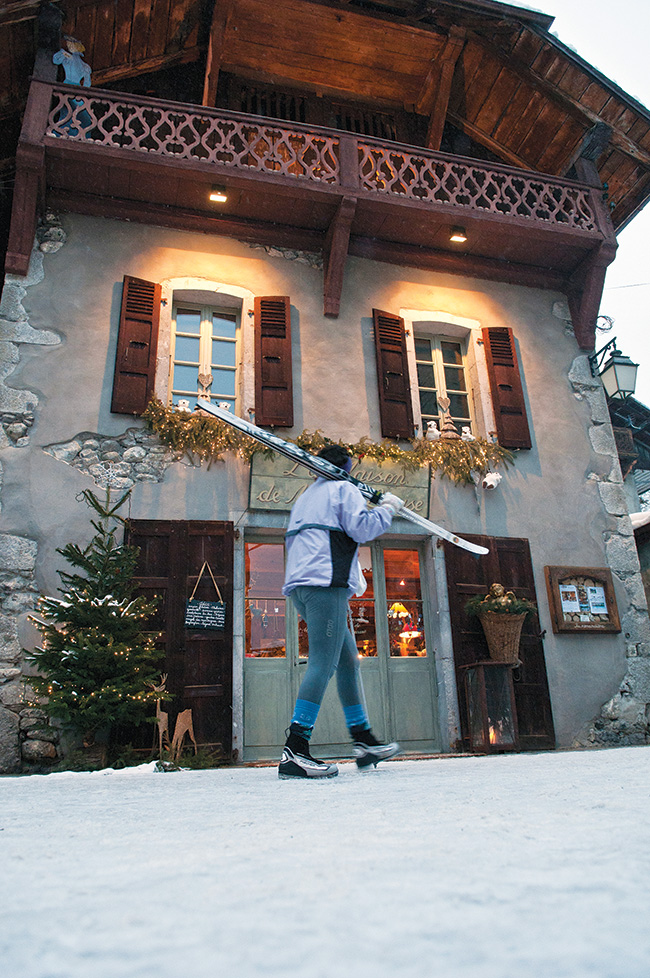
The resort of Samoëns is known for its rather more traditional architecture © Office de Tourisme de Flaine/ M. Dalmasso
Flaine Essentials
Getting There by Air
Geneva airport is one hour’s drive away.
By Train
The TGV station Cluses is a 30-minute bus ride away.
By Car
It normally takes 30 minutes to drive from the A40 autoroute at Cluses.
Where to Stay
Dominic Bliss stayed at the RockyPop hotel (www.rockypop.com).
For more information, visit www.flaine.com
From France Today magazine
Share to: Facebook Twitter LinkedIn Email
More in best ski resorts in France, Flaine ski resort, French ski resorts, skiing in the French Alps
Leave a reply
Your email address will not be published. Required fields are marked *



